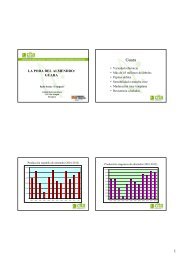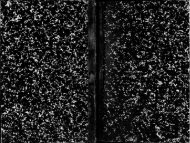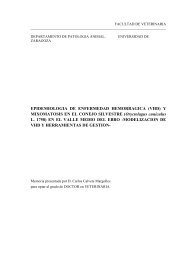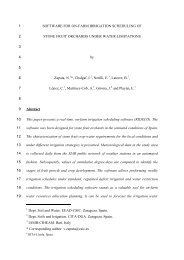1 A Recursive Dynamic Computable General Equilibrium Model For ...
1 A Recursive Dynamic Computable General Equilibrium Model For ...
1 A Recursive Dynamic Computable General Equilibrium Model For ...
Create successful ePaper yourself
Turn your PDF publications into a flip-book with our unique Google optimized e-Paper software.
The second condition is that the aggregator function (A.2) must be linear<br />
homogeneous with respect to each of its inputs. It can be shown that the output price<br />
composite of a linearly homogeneous function is linearly homogeneous in input prices.<br />
Thus, the aggregate quantity and price indices are equal to the sum of the prices and<br />
quantities of the inputs derived in each nest:<br />
n<br />
RX = ∑<br />
i=<br />
1<br />
r<br />
i xi<br />
53<br />
(A.7)<br />
A basic property of linear homogeneous functions is that first order derivatives (i.e.<br />
marginal products/utilities) are homogeneous of degree zero. To demonstrate this<br />
property, take the case of a linearly homogeneous Cobb-Douglas production<br />
function. Hence for a two input production function, MP1 is given as:<br />
∂Y<br />
α −1<br />
β<br />
MP1<br />
= = αAx1 x2<br />
(A.8)<br />
∂x<br />
1<br />
Multiplying each of the inputs by a scalar, λ, yields:<br />
∂Y<br />
MP1<br />
= = αA(<br />
λx<br />
)<br />
∂x<br />
∂Y<br />
MP1<br />
= = λ<br />
∂x<br />
1<br />
1<br />
1<br />
α −1+<br />
β<br />
α −1<br />
1<br />
αAx<br />
∂Y<br />
0<br />
MP1<br />
= = λ [ αAx<br />
∂x<br />
α −1<br />
1<br />
( λx<br />
α −1<br />
1<br />
x<br />
x<br />
β<br />
2<br />
2<br />
]<br />
)<br />
β<br />
β<br />
2<br />
(A.9)<br />
Thus, multiplying both inputs by λ leaves the marginal product of x 1 unchanged. In<br />
other words the marginal products are zero degree homogeneous in inputs. The same<br />
outcome can be proved for input x2. Since the MRTS is the ratio of MPs, then proportional<br />
increases in both inputs by the scalar value λ (implying higher isoquant levels) have no<br />
affect on the MRS. Thus, a ray from the origin must cut all isoquants (indifference) curves<br />
at points of equal slope. Green (1971) states that the isoquants (indifference) curves are<br />
therefore ‘homothetic with respect to the origin’ (pp141).<br />
As a result of this property, Allanson (1989) notes that,<br />
‘optimal factor (commodity) allocations are independent of the level of (aggregate) output<br />
(income)’ (pp.1).
















